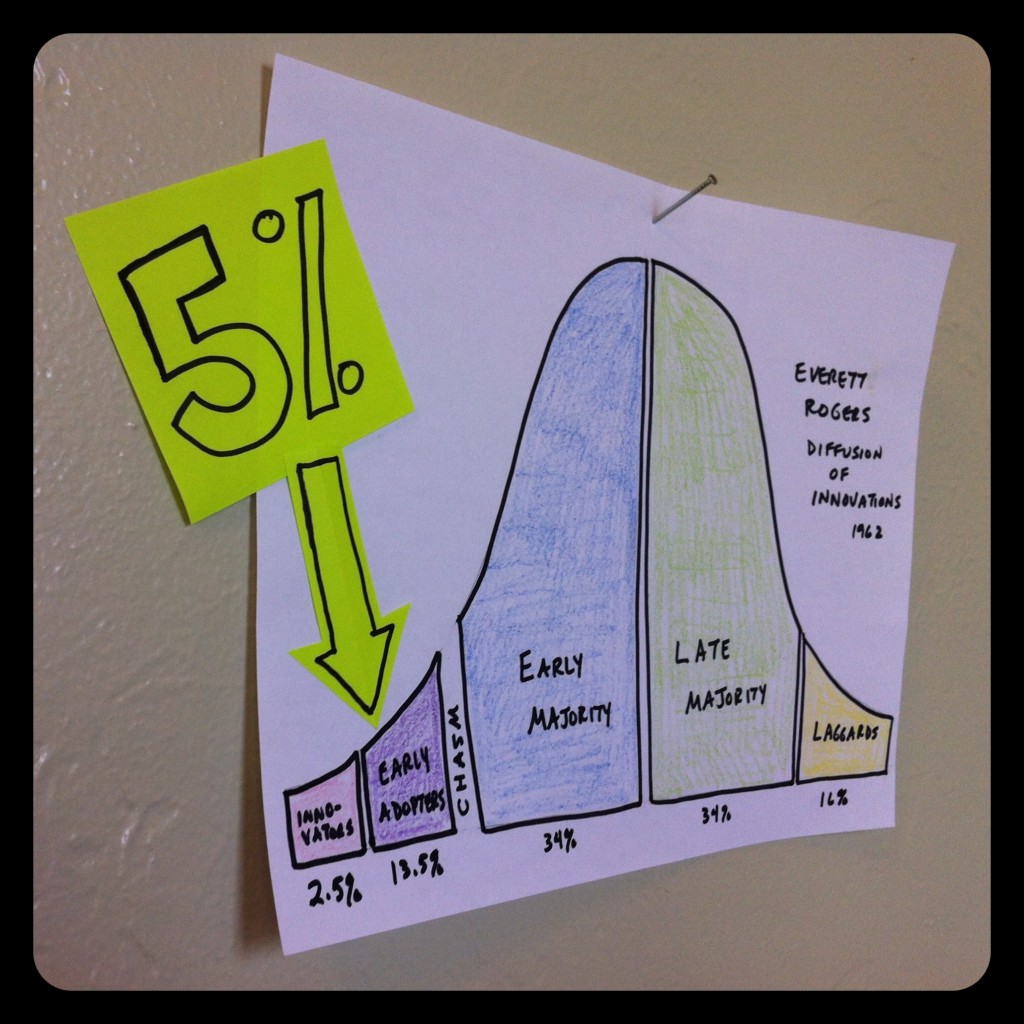The number of Cooperative Baptist Fellowship churches currently pastored by women?
Five Percent.
Eighteen hundred churches. Ninety women.
You do the math.
This is good news. But somehow laying out the starkness of that figure . . . well, it doesn’t exactly add up to great news. Let’s explore the numbers a bit more. And then let’s explore the questions they raise.
The Numbers
To get a picture of where women are, I’ll give you four key sets of figures: seminarians, pastors, chaplains, pastoral candidates. I’ve written a much more comprehensive report for the Review & Expositor, which be published in Spring 2013. For now, the following figures will give you a snapshot.
Seminarians
Before ministry? Most often it’s seminary. When totaled up, women make up over 40% of the enrollment in master’s level programs in more than a dozen CBF-related seminaries and Baptist Houses of Study. This figure is above the national average of schools accredited by the Association of Theological Schools in the U.S. and Canada (ATS), where women made up 30% of the MDiv enrollment in the Fall of 2011. Total enrollment in CBF-related schools is down in the last seven years, as is the total number of U.S. students enrolled in seminary, but the percentage of women keeps growing for Baptists and overall in U.S. schools.[1]
Pastors
Last month Pamela Durso, executive director of Baptist Women in Ministry, gave us a count of women pastors and gave us something to celebrate! In August of 2012, her list included 150 women serving as pastors in the moderate-to-progressive constellation of Baptist churches. The number of women serving today has grown more than ten-fold since Addie Davis was ordained in 1964.
Women serving as pastors[2]
1984 14
1993 51
1997 85
2005 102
2006 117
2007 113
2010 135
2012 150
In late July Paula Dempsey, Minister for Partnership Relations, reported to me that the number of churches affiliating with the Alliance of Baptists is 139. Women are serving as senior pastor, solo pastor or co-pastor in 43 of those congregations.
That’s, 31%.
That’s great news!
Chaplains
The number of women endorsed for chaplaincy is growing. In fact every agency I surveyed this summer has had an increase in both the numbers and the percentages of women over the last seven years, since Pam Durso and I began surveying them for the State of Women in Baptist Life. The increases are as high as seven percentage points.
2012 Chaplaincy Statistics[3]
| Group | Total # | Women | Percentage |
| Alliance of Baptists | 155 | 91 | 59% |
| American Baptist Churches (USA) | 645 | 214 | 33% |
| Cooperative Baptist Fellowship | 658 | 229 | 35% |
| Southern Baptist Convention | 3,567 | 362 | 10% |
| Baptist General Convention of Texas | 727 | 152 | 21% |
Also great news!
Pastoral Candidates
Last week Clarissa Strickland, reference and referral guru at CBF, held 85 active resumes for women in her files. More than a third of them (36) are looking for pastorates. But of course they are open to other positions as well. The others (49) are searching for a variety of church staff and ministry jobs.
A Few Questions
The numbers offer a quick snapshot of the landscape of Baptist women’s leadership in ministry. There are many important stories behind the numbers. For now, I’ll raise and respond to several questions prompted by the numbers.
1. Why is the change so painfully slow?
The first three decades after Addie Davis’ ordination (1964 to 1994) might be considered a time of innovation. Less than 2.5% of Southern Baptist churches adopted the new idea of women becoming pastoral leaders. When Baptist Women in Ministry began in 1983, the Alliance of Baptists formed in 1987 and the Cooperative Baptist Fellowship got started in 1991, the new organizations were part of a major turning point for Baptists. From their beginnings, all three organizations affirmed women’s gifts for ministry and encouraged women’s ordination and place of service in churches and other ministries. Declarations of support, however, do not make social or theological change into reality. They are important – even essential – ingredients for changing the recipe for women’s full participation in the leadership of ministry.
In the last 15 years the change has accelerated. We are living in a time when early adopters are increasingly open to the change of fully accepting women’s leadership. The stories are multiplying and continue to make the rounds in Baptist news outlets and social media networks.
2. “How long will women pastors be news?”
Recently seminary student, Molly Brummett asked: “How long will women pastors be news?” She wrote about her frustration and disappointment with the Cooperative Baptist Fellowship over the track record of calling women as pastors.
Baptist women being called as pastors still make the news several times each year. They are newsworthy, even after more than four decades of change in Baptist life. Women pastors in Baptist churches are still novelties. Even American Baptists who think of women ministers in a much more normative way, only count 485 women pastors among the 5,134 total in 2012. That’s 9.4% of the total number of pastors.[4]
Molly said, “more CBF churches ordain than call women.” She’s right. CBF sends its young women to college and seminary with a blessing. They even ordain them for ministry, but they are still moving slowly to extend a call to pastoral leadership.
One response to Molly’s question is that women being called as Baptist pastors will continue to make news until the idea gets past the innovators and through the early adopters. We’ll have to break the 16% mark and start reaching the early majority of churches. (This is where many mainline denominations are currently.) Somewhere in that time we might stop thinking of women entering Baptist pastorates as either novelties or worthy of headlines.[5]
3. What needs to happen to reach the ‘early majority’?
To move Baptists beyond the “early adopters” group of churches, and into the “early majority” is by the observation of many social scientists a matter of getting across a gap. Part of what makes the gap so hard to cross is that those in the “early majority” need structures of support and a sense of security to really adopt an innovation. Women’s entry into ministry is one of the single most dramatic changes to Christian ministry in two millennia. We are still in the first 50 years of change in a 2000 year history. Taking the long view, this is no simple shift to make. Growth in seminary enrollment, ordinations and service through other ministries are important to the structures of stability that a wider majority needs to risk the gap.
Many of you who read this post will be among the “early adopters.” You are the leaders who will inspire the “early majority” of churches to embrace the pastoral ministry of Baptist women. So let me speak to you as one leader to another . . . Here are some suggestions for making a case to those who are looking to you. Here’s how we might turn some really good news into some great news.
First, invite them to stop worrying about the laggards who will never join this movement. Expending energy trying to overcome their arguments or converting them to another way of thinking is not a good use of resources. They will exhaust your efforts, so don’t spend time and energy fighting with those who openly disagree.
Second, if you are going to expend some energy on leading the innovation of women’s pastoral leadership, then put it into countering the objections of those who say, “I have no problem with women in ministry, but our church is not ready.” How to counter this message? With the good news: “We’ve taken the plunge and things are working out fine! Great in fact!” Or your personal story of seeing and receiving the ministry of a woman. Or try, “Look at all these churches where women’s pastoral leadership is underway. They may not be perfect, but neither are we, and neither is men’s pastoral leadership.” And you might even try this: “Yes, you are ready! You simply need to take a small risk and lead your congregation to give women’s pastoral leadership a try.” Invite them to start with Martha Stearns Marshall Preaching Month in February. Tell them about “Your Sons and Your Daughters Shall Prophesy.”
Finally, share the numbers. For some in the (potential) early majority, they need to see the growth, read the news, and hear the stories of change and women’s leadership. They need to hear Molly Brummett’s question: “is there a place for me as a senior pastor within the future of Cooperative Baptist life?” Tell them about the five percent. Send them a link to this blog. Tell them about how the growth has come slowly over four decades. Tell them there is still time to join the early adopters group – we’ve got room for a few more!
And by all means, thank God for the good news of women’s pastoral leadership. Thank God we may live to see this good news turn into great news. Thank God we are part of this story!
[1] The enrollment numbers were collected in a Leadership Survey of Baptist schools, agencies and governing boards conducted by phone, email and web search by Eileen Campbell-Reed with assistance from Klem-Mari Cajigas Chimelis between July 1 and August 10, 2012 (hereafter, Campbell-Reed, Leadership Survey, 2012).
[2] While there has been no formal listing or registry for Baptist women as pastors, Sarah Frances Anders in the 1980s and 1990s and Pamela R. Durso from 2005 to present, have kept informal lists and published them regularly. See Campbell-Reed and Durso, State of Women in Baptist Life (SWBL), 2005; SWBL, 2006; SWBL, 2007; Pamela R. Durso and Amy Shorner-Johnson, SWBL, 2010. The 2012 numbers come from Pamela R. Durso, “Baptist Women in Ministry List of Women Pastors and Co-Pastors, 2012” unpublished list. Also see Bob Allen, “Historical Mo. church calls woman pastor,” Associated Baptist Press..
[3] Campbell-Reed, Leadership Survey, 2012. The number of women endorsed by the SBC rose from 195 in 2005 to 362 in 2012. Alliance-endorsed women rose from 46 in 2005 to 91 in 2012. CBF-endorsed women rose from 138 in 2005 to 229 in 2012. See also Campbell-Reed and Durso, SWBL, 2005.
[4] ABC-USA Professional Female Summary, August 7, 2012.
[5] There is not a one-to-one correlation of numbers between how many churches are open to calling women and how many actually employ them as pastors at a given point in time. Lip service to openness is not the same as taking the risk of innovation. And genuine openness will be to both men and women.





Hi, Carrie – there is work to do! More women feel an inward call than receive an outward call. And hundreds more women are serving in other roles of ministry. Many of them are satisfied with their ministries, and don’t necessarily feel a call to preach or lead a congregation as pastor. However, many who do feel that call do not receive an outward call from a congregation. Some wait for years. Some leave and go to other denominations. Some find other ways to be fulfilled in their vocations. In every one of these cases it is the Baptist churches which are the big losers. We’ll celebrate each bit of progress!